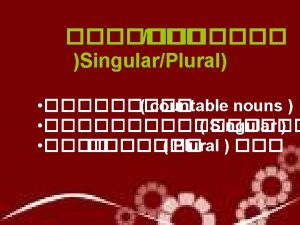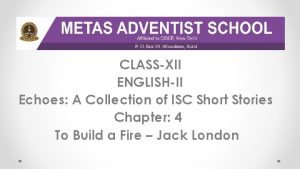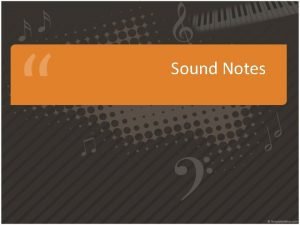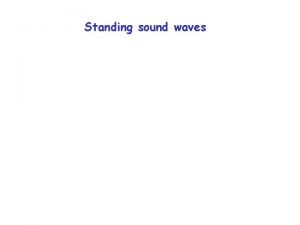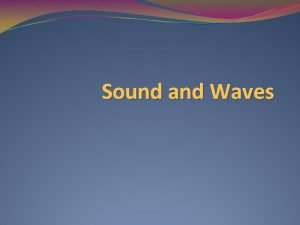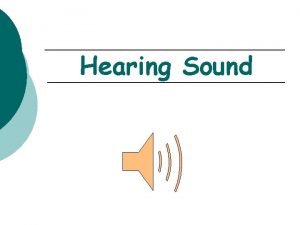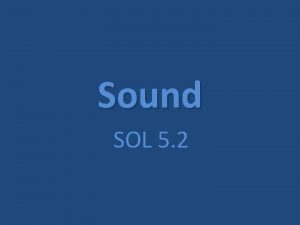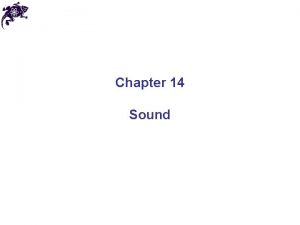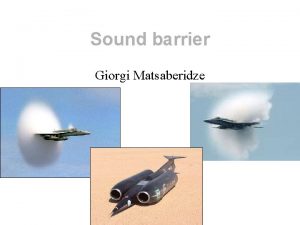Sound Part 3 Multiple Echoes Here is a

















- Slides: 17

Sound, Part 3

Multiple Echoes • Here is a recipe to create multiple echoes: def echoes(sndfile, delay, num): s 1 = make. Sound(sndfile) ends 1 = get. Length(s 1) ends 2 = ends 1 + (delay * num) #ends 2 is in samples – convert to seconds and make empty sound that long s 2 = make. Empty. Sound(1 + int(ends 2 / get. Sampling. Rate(s 1))) echo. Amplitude = 1. 0 for echo. Count in range(1, num + 1): echo. Amplitude = echo. Amplitude * 0. 6 for pos 1 in range(1, ends 1): pos 2 = pos 1 + (delay * echo. Count) value 1 = get. Sample. Value. At(s 1, pos 1) * echo. Amplitude value 2 = get. Sample. Value. At(s 2, pos 2) set. Sample. Value. At(s 2, pos 2, value 1 + value 2) play(s 2) return s 2

Splicing Sounds • Say we want to splice pieces of speech together extracting words from the same sound file: – Find the end points of words – Copy the samples into the right places to make the words come out as we want them – (We can also change the volume of the words as we move them, to increase or decrease emphasis and make it sound more natural. )

Finding the word endpoints • Using Media. Tools and play before/after cursor, can figure out the index numbers where each word ends Change to: “We the United People of the United States…”

Now, it’s all about copying • We have to keep track of the source and target indices, src. Index and dest. Index = Where-the-incoming-sound-should-start for src. Index in range(starting. Point, ending. Point): sample. Value = get. Sample. Value. At(source, src. Index) set. Sample. Value. At(dest, dest. Index, sample. Value) dest. Index = dest. Index + 1

How to do it • First, set up a source and target. • Next, we copy “United” (samples 33414 to 40052) after “We the” (sample 17408) – That means that we end up at 17408+(4005233414) = 17408+6638=24046 – Where does “People” start? • Next, we copy “People” (17408 to 26726) immediately afterward – 24047 + (26726 -17408) = 33365 – Do we have to copy “of” to? – Or is there a pause in there that we can make use of? • Finally, we insert a little (1/441 -th of a second) of space – 0’s

The Whole Splice def splice. Preamble(): file = "/Users/sweat/1315/Media. Sources/preamble 10. wav" source = make. Sound(file) dest = make. Sound(file) # This will be the newly spliced sound dest. Sample = 17408 # target. Index starts after "We the" in the new sound for src. Sample in range(33414, 40052): # Where the word "United" is in the sound set. Sample. Value. At(dest, dest. Sample, get. Sample. Value. At( source, src. Sample)) dest. Sample = dest. Sample + 1 for src. Sample in range(17408, 26726): # Where the word "People" is in the sound set. Sample. Value. At(dest, dest. Sample, get. Sample. Value. At( source, src. Sample)) dest. Sample = dest. Sample + 1 for index in range(1, 1000): #Stick some quiet space after that set. Sample. Value. At(dest, dest. Sample, 0) dest. Sample = dest. Sample + 1 play(dest) #Let's hear and return the result return dest

What if we didn’t do that second copy? Or the pause? def splice. Preamble(): file = "/Users/sweat/1315/Media. Sources/preamble 10. wav" source = make. Sound(file) dest = make. Sound(file) # This will be the newly spliced sound dest. Sample = 17408 # target. Index starts after "We the" in the new sound for src. Sample in range(33414, 40052): # Where the word "United" is in the sound set. Sample. Value. At(dest, dest. Sample, get. Sample. Value. At( source, src. Sample)) dest. Sample = dest. Sample + 1 #for src. Sample in range(17408, 26726): # Where the word "People" is in the sound #set. Sample. Value. At(dest, dest. Sample, get. Sample. Value. At( source, src. Sample)) #dest. Sample = dest. Sample + 1 #for index in range(1, 1000): #Stick some quiet space after that #set. Sample. Value. At(dest, dest. Sample, 0) #dest. Sample = dest. Sample + 1 play(dest) #Let's hear and return the result return dest

Making Sine Waves • We can build our own waves using trigonometry functions like sine or cosine 1 π 2π -1 Let’s say that we want the sound to play at 440 hz ; that is one cycle in 1/440 sec = 0. 00227 seconds If our sampling rate is 22, 050 samples per second, then for one cycle we need: 0. 00227 (seconds) * 22050 (samples/second) = 50 samples Get a sample from the sine wave every (2 * pi) / 50 and repeat

Generating a Sine Wave • To build the sine wave – Compute sample interval from the sine function • samples. Per. Cycle = (1/freq) * sampling. Rate • sampling. Interval = (2 * pi) / samples. Per. Cycle – Generate blank sound of desired length – Loop through each sample of the blank sound • Set it to the next sample from the sine wave

Sine Wave Function def sine. Wave(frequency, amplitude, duration): snd = make. Empty. Sound(duration) interval = 1. 0 / frequency samples. Per. Cycle = interval * get. Sampling. Rate(snd) sampling. Interval = (2 * 3. 14159) / samples. Per. Cycle sample. Value = 0 for pos in range (1, get. Length(snd) + 1): raw. Sample = sin(sample. Value) sample. Val = int(amplitude * raw. Sample) set. Sample. Value. At(snd, pos, sample. Val) sample. Value = sample. Value + sampling. Interval play(snd) return snd

Did it work? • Test with different frequencies, durations, amplitudes • Save to a file and examine with media tools – write. Sound. To(snd, “filename. wav”) • Getting fancier – Can add sine waves together, just like we did with . wav files, to generate chords and more interesting sounds • Early computers used sine waves, square waves, and triangle waves to make sound

MP 3 • Today, many audio files are stored using the MP 3 format • Data is compressed so it requires less space • Lossless compression – Instead of storing each sample, what if we only stored the difference from the last sample? – The difference is usually much smaller than 32767 to -32768. It might only be +/- 100, which would require fewer bits to store • Lossy compression – Throws away some of the sound, especially at higher frequencies, that you can’t hear • E. g. soft sound simultaneously played with a loud sound • WAV files also compressed, using a lossless compression technique

MIDI • Musical Instrument Digital Interface – Standard for synthesizers so different musical hardware can interoperate with a computer – Can specify notes and instruments – JES has a built-in MIDI player using a piano • The musical scale, starting at middle C, proceeds as follows: C C sharp D D sharp E F F sharp G A flat A B …

MIDI • The MIDI format assigns a numerical value to each note. The table below shows some notes and their numeric values. Musical Note Numeric Value C (middle C) 60 C Sharp 61 D 62 D Sharp 63 E 64 F 65 F sharp 66 G 67 A flat 68 A 69 . . .

play. Note • The play. Note function is: – play. Note(note, duration, velocity) Note - This is the numeric value corresponding to the note using the table above. The value can actually range between 0 and 127, so you can use values below 60 for lower octaves below Middle C, and larger values for higher octaves. Duration. The duration is how long to play the note in milliseconds. A duration of 1000 would play the note for one second, while a duration of 250 would play the note for a quarter of a second. Volume or Velocity. In a metaphor to a piano, the velocity is how hard you hit the key and thus corresponds to the volume of the note. A velocity of 0 is silent while the highest velocity is 127.

Sample Programs def play. Scale(): for note in range(60, 71): play. Note(note, 1000, 127) def play. Song(): play. Note(60, 500, 127) # C play. Note(67, 500, 127) # G play. Note(69, 500, 127) # A play. Note(67, 1000, 127) # G play. Note(65, 500, 127) # F play. Note(64, 500, 127) # E play. Note(62, 500, 127) # D play. Note(60, 1000, 127) # C
 Atlantic revolutions in a global context
Atlantic revolutions in a global context Singular plural of tomato
Singular plural of tomato Echoes a collection of isc short stories
Echoes a collection of isc short stories Chapter 17 atlantic revolutions and their echoes
Chapter 17 atlantic revolutions and their echoes Here i bow down here i bow down
Here i bow down here i bow down Multiple probe vs multiple baseline
Multiple probe vs multiple baseline Multiple instruction multiple data
Multiple instruction multiple data “a sound mind is in a sound body”
“a sound mind is in a sound body” What is sound
What is sound Graph travel
Graph travel Part whole model subtraction
Part whole model subtraction Part to part ratio definition
Part to part ratio definition Brainpop ratios
Brainpop ratios What is a technical description
What is a technical description Describe the parts of a front bar
Describe the parts of a front bar The phase of the moon you see depends on ______.
The phase of the moon you see depends on ______. 미니탭 gage r&r 해석
미니탭 gage r&r 해석 Na why are we here
Na why are we here

